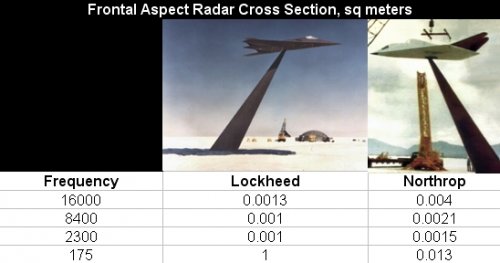- Joined
- 11 February 2010
- Messages
- 1,445
- Reaction score
- 1,940
Greetings.
As in title above. Im still working on even more improved version of my AESA radar range calculation spreadsheet, and naturally with increase of wavelength one tried to calculate, there would be a question "what value i should input as RCS of target ?" Based on several textbook, mainly Knott and Tuley's famous "Radar Cross Section" 2nd Edition. There is wavelength dependency on RCS. Problem is that i found no real means to get "ballpark figure" on how much increase or decrease of RCS according to wavelength.
The book however includes nice figure that low RCS object that designed for X-band may have 18 dB more RCS in L-band (1250 MHz) Thus object having -30 dB RCS in X-band may have -12 dB in L-band. But how about the VHF band or even HF band ?
Another "ballpark" figure i could find is in the Bill Sweetman article :
http://aviationweek.com/defense/commentary-do-russian-radar-developments-challenge-stealth
Which stated that RCS for Chinese ballistic missile in X-band is 0.002 sqm (-27 dB) while in VHF it would be 0.6 sqm (-2.2 dB) Or about 24 dB increase. But i wonder if it would be applicable at least as early estimates on how far my VHF or L-band radar would are against low RCS target.
Another thing of interest is, should this ballpark figure (if found) Be applied on conventional target too. I browse on ausairpower page on the Nebo SVU and found range/altitude coverage plot, which states detection range for MiG-21 with RCS of 2.5 Sqm. Is this 2.5 sqm in VHF or other band.
If the 2.5 sqm (4 dB) figure is in VHF, applying the ballpark figure from the DF-15 would yield RCS of -20 dB or 0.01 sqm for X-band. Or should i just leave it as 2.5 ? This however in my view at least make comparing VHF band radar with its lower wavelength sibling invalid as there are no indication of "reference wavelength"
Applying the opposite (2.5 sqm is for X-band) adding 24 dB makes it 28 dB or incredible 627 sqm of RCS which basically state that detection range of MiG-21 fighter would only be limited by Horizon and of course the pattern propagation factor (F^4).
I guess that is all for my question. Thank you very much for any response.
As in title above. Im still working on even more improved version of my AESA radar range calculation spreadsheet, and naturally with increase of wavelength one tried to calculate, there would be a question "what value i should input as RCS of target ?" Based on several textbook, mainly Knott and Tuley's famous "Radar Cross Section" 2nd Edition. There is wavelength dependency on RCS. Problem is that i found no real means to get "ballpark figure" on how much increase or decrease of RCS according to wavelength.
The book however includes nice figure that low RCS object that designed for X-band may have 18 dB more RCS in L-band (1250 MHz) Thus object having -30 dB RCS in X-band may have -12 dB in L-band. But how about the VHF band or even HF band ?
Another "ballpark" figure i could find is in the Bill Sweetman article :
http://aviationweek.com/defense/commentary-do-russian-radar-developments-challenge-stealth
Which stated that RCS for Chinese ballistic missile in X-band is 0.002 sqm (-27 dB) while in VHF it would be 0.6 sqm (-2.2 dB) Or about 24 dB increase. But i wonder if it would be applicable at least as early estimates on how far my VHF or L-band radar would are against low RCS target.
Another thing of interest is, should this ballpark figure (if found) Be applied on conventional target too. I browse on ausairpower page on the Nebo SVU and found range/altitude coverage plot, which states detection range for MiG-21 with RCS of 2.5 Sqm. Is this 2.5 sqm in VHF or other band.
If the 2.5 sqm (4 dB) figure is in VHF, applying the ballpark figure from the DF-15 would yield RCS of -20 dB or 0.01 sqm for X-band. Or should i just leave it as 2.5 ? This however in my view at least make comparing VHF band radar with its lower wavelength sibling invalid as there are no indication of "reference wavelength"
Applying the opposite (2.5 sqm is for X-band) adding 24 dB makes it 28 dB or incredible 627 sqm of RCS which basically state that detection range of MiG-21 fighter would only be limited by Horizon and of course the pattern propagation factor (F^4).
I guess that is all for my question. Thank you very much for any response.

